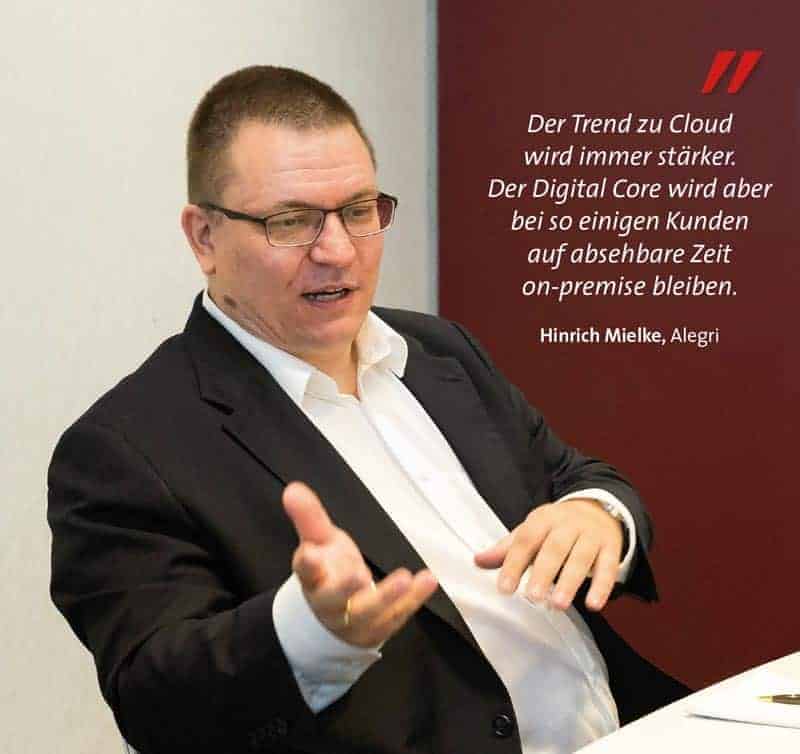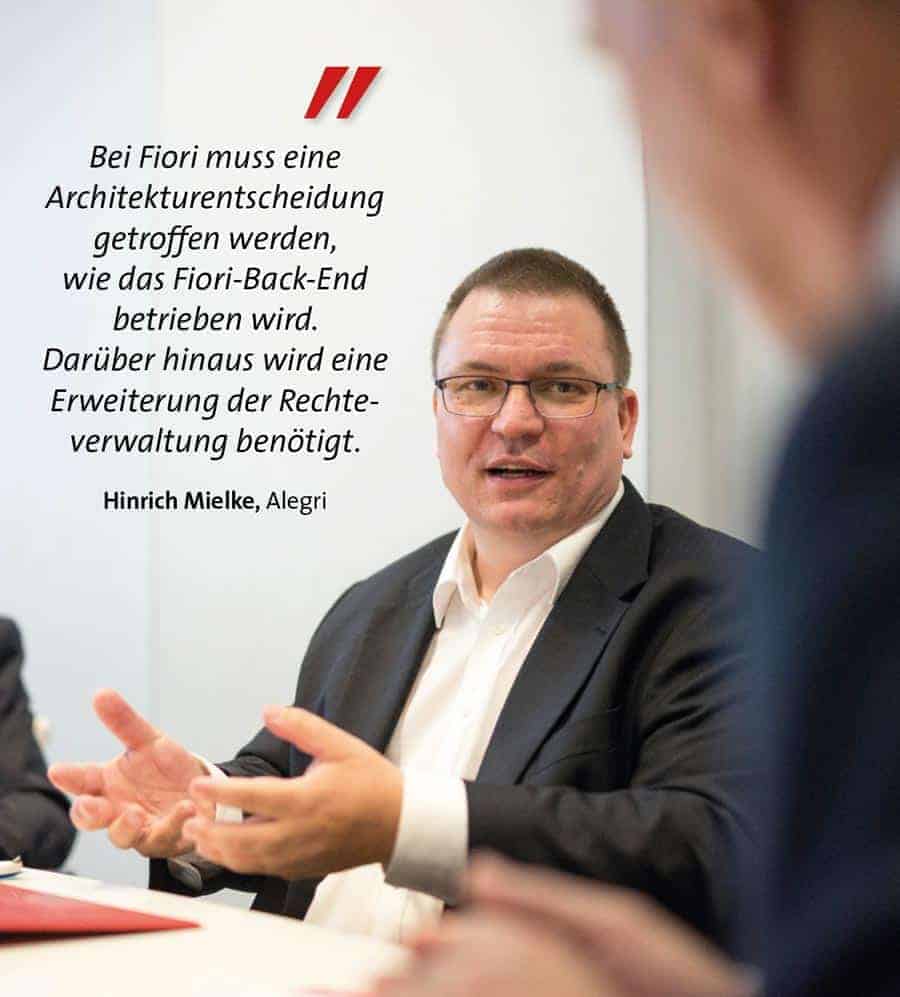Private Roadmap S/4


One of the best SAP experts for strategy, planning and operations is Hinrich Mielke from Alegri. He is an occasional E-3 author and is intensively involved with Hana and S/4 roadmaps on-premise and off-premise.
He has already customized S/4 for many existing SAP customers and also successfully migrated it to the Microsoft Azure cloud platform. At the end of the year, Hinrich Mielke, SAP Director at Alegri, once again found time for an interview with E-3 editor-in-chief Peter M. Färbinger.
Peter M. Färbinger, E-3 Magazine: Mr. Mielke, you talk to a lot of customers - what touches CIOs on the subject, how do you "go about it" and what are the pitfalls?
Hinrich Mielke, Alegri: The journey to S/4 Hana is one of the most complex topics in IT. Due to the overlap with the topic of the cloud, it ranges from the provision of the infrastructure, database, modified application and the associated collaboration with the business side to a changed support model, agile software development and an increasing fusion of analysis and transactional data processing.
The front end for the end user is modernized and mobilized with Fiori. As a result of this and the possibilities of code push-down, the requirements for rights management within Fiori and the database as well as hybrid approaches in administration in general are expanding.
As always with complex topics: It helps to bring structure into it and to look at one aspect at a time in a pragmatic way. It is important not to get lost in the details - but to look at the big picture.
Färbinger: Easier said than done - how do you get started?
Mielke: With a clean inventory: Which systems and services are currently being operated and how? Application, criticality, the basic technical data and its development over time as well as the operating model are important.
In addition, the foreseeable changes over the next one to two years. How will the systems be operated, what is in-house, what is outsourced or outsourced?
Always important: What is my license status, which systems did I procure when and under what conditions? Then a look at the IT customers:
Which specialist areas have been served so far and how, are there formal agreements and framework conditions? What is the level of knowledge of my key users - what is the maturity level for changes? What test cases are there? How are they documented? Is testing already automated? How are interfaces documented?
Now the creative part: What changes will there be in my specialist areas? What new business models will the digital transformation enable for my company?
Färbinger: That sounds extensive - can it be shortened?
Mielke: Unfortunately not really, but you can tackle it bit by bit, but the right order is important - because sooner or later all these aspects will become essential. Much of this information already exists, sometimes only in our heads.
A collection and documentation are essential here. Bonus: This makes the subsequent procedure much easier and reduces costs. Gaps that arise now can be closed without time pressure and in good quality, and preliminary projects can be set up.
Färbinger: Pre-projects?
Mielke: We keep meeting customers who are not yet on Unicode. This is a great preliminary project: after the changeover to Unicode, you have an up-to-date interface description, documented test cases and typically also a technically up-to-date and optimized environment.
Other preliminary projects include automation of testing, conversion to business partners and a new general ledger. The code inspection of in-house developments can also be carried out in advance, thus reducing the scope of the main project.
Know-how on the topics of Abap, Hana and S/4 is also built up at the same time - essential for high-performance developments with SAP Hana. It is important that the business mission of IT is defined, the target picture is clear, an overall strategy is developed and a master plan is drawn up.
Färbinger: Let's talk about the goal: where should the journey for the customer go technically? On-premise or in the cloud? Which cloud? And why?
Mielke: The trend towards the cloud is becoming ever stronger. For some customers, the digital core will remain on-premise for the foreseeable future. However, more and more customers have a "cloud first" strategy in which they have to justify why a new application is not operated in the cloud.
A distinction must be made between SaaS, PaaS and IaaS. Let's talk about IaaS first: IaaS can play to its strengths with Hana systems in particular, as changes to sizing can be made within a short period of time.
Färbinger: Can you be more specific here?
Mielke: Gladly. Technically, a system can be reseted within minutes. However, with shutdown and restart and loading the Hana database, this can also take hours - depending on the performance of the infrastructure, the size of the database and the complexity of your system environment.
The choice of cloud should be carefully considered. Switching is possible, but costly. This means you should keep the switching costs low and then decide on the right cloud. You may already be using other services from the provider, in which case it makes sense to stay with them.
For example, customers with Office 365 have already clarified contracts, data protection aspects and works council issues with Azure. The hurdle here is low. Customers in the retail sector may not want to have a direct competitor as a supplier.
With the "new kid on the block", you may be able to get good deals as an early customer and thus have an advantage.
Färbinger: Why the IaaS cloud?
Mielke: Even if all systems remain on-premise in the future: For the transition period, IaaS is unbeatably flexible and - if operated correctly - also cost-effective.
Project, test and training systems can be used cost-optimized in the pay-as-you-go model and Capex can then be turned into Opex - which can also be charged to the source.
Färbinger: A good keyword: What does the business side gain from the switch to S/4 Hana apart from a lot of work and changed processes?
Mielke: Well, this is where SAP would normally place an advertising block - but I'm going to keep it short: the first improvements came in FI/CO:
The elimination of tables and indices has reduced data volume and complexity while speeding up evaluations. This is not only due to the technical possibilities of the in-memory computing database, but also due to the extensive denormalization of the database.
The convergence of FI and CO reduces month-end reconciliations between Controlling and Financial Accounting. There are comparable changes in logistics that lead to optimization. A few percentage points of improvements in logistics quickly result in very significant savings potential.
In addition, customer satisfaction can be increased thanks to improved logistics processes. The changes can be found in detail in the "Simplification List". Now with more than 1000 pages - but still available in German.
Färbinger: And the specialist side gets a new ERP interface, right?
Mielke: The front end is complemented by Fiori, a modernized and flexible interface. With Fiori, even the occasional user can use SAP and monitor the status of workflows beyond transactions, find out about KPIs and configure deadline monitoring.
Färbinger: Sounds good, but what's the downside? Is it possible without Fiori?
Mielke: With Fiori, an architectural decision must be made as to how the Fiori back-end is operated. In addition, an extension of the rights management is required.
If the standard Fiori is not sufficient, development is required. The developers must build up the relevant expertise and, if necessary, the role of UI designer must also be filled.
In my opinion, however, there is no alternative, because Generation Z demands interfaces that match their life experience, and SAP only offers some functionalities with Fiori.
There are also customers who want to use Fiori as early as possible for internal marketing reasons. With the Fiori Booster methodology, we offer them the opportunity to use any standard S/4 Fiori with ERP/ECC 6.0.
Färbinger: Now to the changeover - first to Hana and then S/4, or Big Bang?
Mielke: Most customers take a two-step approach to ERP: first ERP/ECC with Hana, then the switch to S/4. The essential involvement of the business side in the transformation to S/4 takes time.
The switch to Hana is more of an internal IT project. The database and possibly the operating system are changed - everything else remains the same. Experience with Hana and the operating system can then be gained and the operating processes established and refined.
Don't forget the cloud, the integration of IaaS must also be established, ideally it is irrelevant not only for the user but also for the administrator where the system is running. Big Bang is often chosen for systems with little or no in-house development.
Färbinger: But is it possible to calculate a business case for the first step "Suite on Hana"?
Mielke: Now it becomes fundamental. If every IT project has to have a business case, it becomes difficult to innovate. The first cars were also more expensive and less reliable than horse-drawn carriages - obviously no business case.
A company that allows the CIO to justify each project separately as profitable is depriving itself of innovative strength. I am certain that companies that do not actively approach the innovative power of Hana, S/4, Fiori etc. with open arms will face difficulties in the medium term.
We experience this with some customers: Over the years and decades, no fundamental renovation has been carried out, but rather, like an onion, new layers have been placed around existing ones.
Now, like Gulliver in the Lilliputians, you are trapped by a multitude of systems and applications and can hardly move. SAP S/4 Hana with the possibility of integration is an opportunity to consolidate and modernize core processes.
Exciting new applications and innovations can then be connected to the core system. Because, and this brings us back to the business case, innovations must also make a business contribution, and this is realized in the ERP.






